William C. C. Chen's Tai Chi Body Mechanics Videos
Tai Chi Chuan workshops in Hanover Germany
Channel:
Essential Sports and Fitness Videos (Tai Chi)
The Tai Chi and Martial Arts Video Channel includes the full 14 chapters of Grandmaster William C. C. Chen's "Body Mechanics" DVD.
It's an excellent introduction to Tai Chi as an exercise for improving balance, a form of moving meditation to reduce stress, and
a martial art that emphasizes softness overcoming hardness.
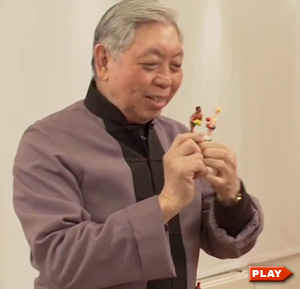
Body Mechanics of Tai Chi Chuan - Chapter 3
The role of the feet and inner thigh muscles. (00:09:34)
Grandmaster Chen explains the position of the legs, how weight is distributed,
the "three nails" of the feet, and the importance of the big toe.
He uses toy boxers to illustrate how the inner thighs play their part
and elaborates on how he made Professor Cheng Man Ching's form a little "sweeter".
From: William C. C. Chen and Nils Klug (Body Mechanics DVD)
To watch this clip, click on picture
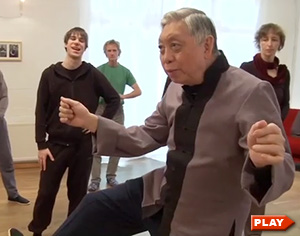
Body Mechanics of Tai Chi Chuan - Chapter 6
Tilting to gain leverage. Keeping the back straight. (00:03:28)
Grandmaster Chen explains when to tilt and the difference between keeping the body straight versus upright.
He explains why he added "needle at the bottom of the sea" (from the Yang Long Form) to the Short Form.
Finally, he demonstrates how the Tai Chi kick requires energizing the fingers ("breaking the chop sticks").
From: William C. C. Chen and Nils Klug (Body Mechanics DVD)
To watch this clip, click on picture
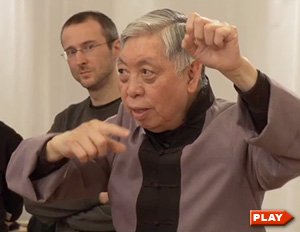
Body Mechanics of Tai Chi Chuan - Chapter 8
Compression and physical conditioning. (00:03:33)
Grandmaster Chen explains the role of compression and pressure in creating power and the role of muscles in supporting
that power. He focuses on the analogy of air in a tire versus the rubber that holds that air.
From: William C. C. Chen and Nils Klug (Body Mechanics DVD)
To watch this clip, click on picture
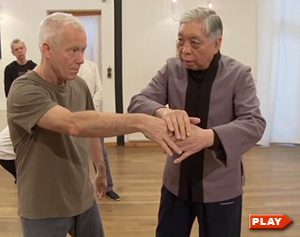
Body Mechanics of Tai Chi Chuan - Chapter 9
Spirals - turning and spinning. (00:05:39)
Grandmaster Chen explains that many sports follow the same principles for producing power.
"Spiraling down" is an internal wind-up for the move, and "spiraling up" (spinning out) executes the external move.
He reveals how use of the fingers and toes, the breathing pattern, and the state of mental awareness all can
contribute to a move's power.
From: William C. C. Chen and Nils Klug (Body Mechanics DVD)
To watch this clip, click on picture
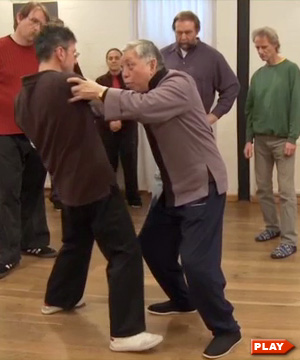
Body Mechanics of Tai Chi Chuan - Chapter 12
Tai Chi push hands - expanding and disappearing. (00:09:19)
Grandmaster Chen demonstrates the difference between "energy pushing" and pushes
that come from tensing the muscles of the arms and legs.
He shows how to uproot an opponent, how to disappear under a push (without injuring your back), how to
resist by sinking down instead of using muscles to push back, and how to drag
down a person who is pushing by their arm. He illustrates the difference between
slow fa-ching (pushing) for push hands and fast fa-ching for martial arts
applications.
From: William C. C. Chen and Nils Klug (Body Mechanics DVD)
To watch this clip of Grandmaster Chen teaching this advanced Tai Chi lesson,
click on picture
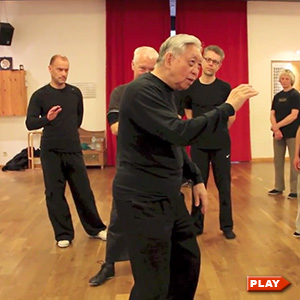
Tai Chi Worshop in Hanover 2013-05
To put energy into the fingers, use your heart, not just your mind. (00:04:59)
Grandmaster Chen starts with his theory of "four-wheel drive".
He shows how one hand helps the other, and both feet must participate in any action.
Next, he talks about Chi (internal energy) and uses rubber tubing to demonstrate how Chi is about reaching and holding a position
without adding muscular force.
Finally, he discusses and demonstrates how to get energy into the fingers.
From: William C. C. Chen and Nils Klug
To watch this clip of William Chen in action, click on picture
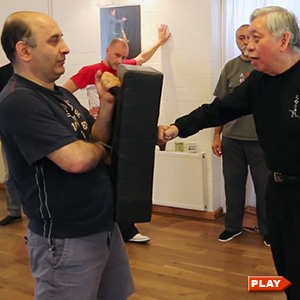
Tai Chi Worshop in Hanover 2014-06
"From something to nothing. From nothing to something." (00:05:03)
Grandmaster Chen explains that the fingers are the key to action
and describes the energetic connection between the fingers, the heart, and the toes.
He shows how power and speed come from the combination of spiralling from the ground and floating from the ribs.
Finally, he demonstrates with a few practical self-defense applications how the relaxation and focus of the Tai Chi form lead to the
flexibility to strike from any position.
From: William C. C. Chen and Nils Klug
To watch this clip of William Chen in action, click on picture
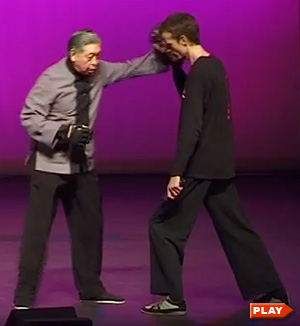
Form and Application Demo
Tai Chi Chuan as self-defense. Cheng Man-Ching Forum 2004. (00:08:08)
Grandmaster Chen and Sifu Nils Klug go through the first portion of the Yang Short Form (with a nice Sitar background).
Then Grandmaster Chen explains the relationship between slow, calm movements and martial arts.
Then he shows how speeding up particular moves of the Tai Chi form leads to an effective jab, cross, hook, roundhouse,
and uppercut.
From: William C. C. Chen and Nils Klug
To watch this clip of William Chen in action, click on picture
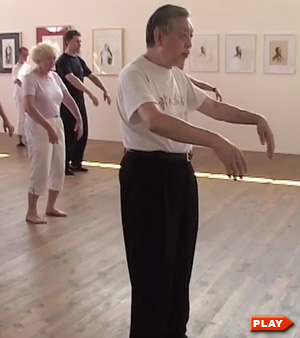
Workshop in the Body Mechanics of the Tai Chi Form
Cheng Man-Ching Forum 2004 (Hanover, Germany). (00:05:54)
Grandmaster Chen explains and shows how the breathing pattern (inhale and exhale) naturally follows the alternating
increase and decrease in the Tai Chi form of mental awareness ("waking up and falling asleep" by collapsing, sinking, and sagging).
He demonstrates the role of the big toe, ball of the foot, and heel (the "three nails") in
movement and creating spin from the ground.
From: William C. C. Chen and Nils Klug
To watch this clip of William Chen in action, click on picture
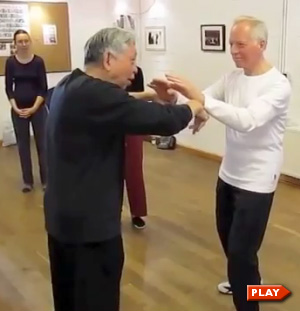
Body Mechanics of Tai Chi Chuan
Workshop by William C. C. Chen in Hanover - short (2004). (00:02:24)
Clips from one of Grandmaster Chen's Body Mechanics workshops in Germany.
He demonstrates:
Expanding your energy and making use of your opponents force to push
Driving energy from your chest walls ("heart") for a two-handed strike
Connecting to your inner thigh and alternating between loose and tense to create high speed hooks.
From: William C. C. Chen and Nils Klug
To watch this clip of William Chen in action, click on picture
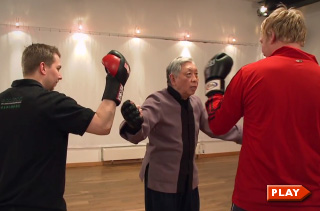
Body Mechanics of Tai Chi Chuan
Demonstrates Tai Chi boxing, push hands, and the short form. (00:02:25)
Grandmaster Chen's specialty is teaching the connection between the Tai Chi movements and achieving great
speed and power for self defense.
This trailer has clips from workshops conducted in Germany that show high speed punches, push hands techniques,
and internal principles.
From: William C. C. Chen and Nils Klug
To watch this clip of William Chen in action, click on picture